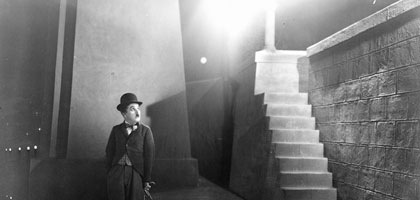Charlie as a Searchlight
by Michael Hammond

City Lights
Charlie Chaplin is arguably the most popular figure in the history of cinema. It seems strange then that this may be the first conference on his influence and his work. While there have certainly been retrospectives of his films at festivals there has until now been no attempt to bring together scholars, archivists and collectors together to consider his impact, his influences and the creative environment from which he arose and that he worked in.
Think for a moment of Chaplin's impact on cinema, not to mention dance, theatre, politics and even modern philosophy, and it becomes clear that as time goes on his work, his influences, and his place in film history are due for some concentrated consideration. This is what we hope to instigate, and of course in many ways continue, as the diversity of the work represented by our delegates at the conference demonstrates.
The range of papers here covers the reach of Chaplin's impact from his music hall roots, his use of 19th-century melodrama through his use of those influences to shape a timely and controversial style. His use of seemingly outdated modes such as sentiment and mime shaped a powerful exposition of the inequities and disasters and the very texture of living in the twentieth century. Those qualities did not simply appeal in widely different ways internationally, country-by-country and region-by-region - they prompted imitation in ways that owe as much to the popular performance traditions of those countries as they do to Chaplin's artistic ancestry. In that sense Chaplin is not so much an originator as he is a catalyst. Further, Chaplin's experience on the world stage and as a politically controversial figure offer important instances of celebrity-under-scrutiny that have a familiar ring here at the beginning of the twenty-first century.
As if this were not enough to be getting on with the value of Chaplin as a subject in writing a more complete history of film generally and of Hollywood and its domination of world screens is inestimable. Aesthetically of course but also in tracing the history of distribution and reception in both the US and the world Chaplin offers a high profile example, a test case, which can be used to help understand the wider influence of film and Hollywood generally, particularly when in many cases his work survives where so much of the early and silent cinema culture does not. Such a diverse approach to Chaplin then offers much more than the study of one man's influence.
What we hope to achieve here is not a revalidation of Chaplin's abilities, or his status as 'genius'. That is probably not necessary. Instead, in these few days of the conference, we hope to point to Chaplin's role in the history of cinema and indeed of the twentieth century and more importantly to use Chaplin as a 'historical' searchlight that could help illuminate the history of a global yet distinctly diverse mass-produced entertainment culture.